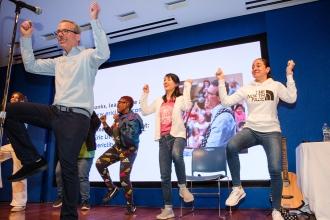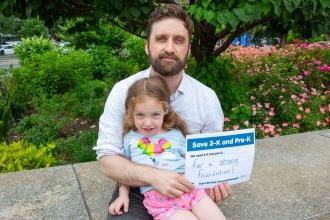Early Childhood Conference

Teresa Bello, who teaches at PS 185 in Manhattan, shows off one of her handmade puppets as she leads the
“Puppet & Flannel Board Stories” workshop.

Anna Roche, who teaches at the District 20 Pre-K Learning Center in Brooklyn, fills out a “Save 3-K and Pre-K” postcard at the UFT Early Childhood Conference.

Author and educator Eric Litwin leads early childhood educators as they dance to his “Polka Dot Pants” song during his “Joyful and Engaging Early Reading” workshop.
They swung their arms wildly in big circles while singing and high-stepping, but this was no aerobics class: It was a group of early childhood educators practicing how to engage young children through language, poetry, music and fun.
“Polka-dot do, do, do, polka-dot pants, polka-dot pants dance. Go this way, go that way, go this way, go every way!” they belted out as they parroted Eric Litwin, the original author of the popular “Pete the Cat” children’s book series.
It was a day of inspiration and learning for the approximately 400 educators who attended the UFT’s 16th annual Early Childhood Conference at union headquarters on April 6. In his keynote address and during one of the workshops, Litwin, a former elementary school teacher, told stories, sang songs and gave tips for engaging young readers.
“It’s about love and engagement and immersion,” he said. “We have to get them involved. We have to make sure that learning to read and reading is the most fun we do all day.”
Deborah Lopez, who teaches pre-K at PS 63 Authors’ Academy in the Bronx, said Litwin inspired her to make some changes in her classroom.
“My kids read the book and they sing along to it,” she said of “Pete the Cat.” “Adding the movements will engage them more.”
Members at the conference also were made aware of the vulnerabilities the city’s 3-K and pre-K programs face. UFT Vice President for Elementary Schools Karen Alford and UFT President Michael Mulgrew asked them to join the fight to restore funding for 3-K and pre-K that the Adams administration had cut midyear. At the daylong event, members sent emails to the mayor and the schools chancellor demanding that they reverse funding cuts, step up their marketing efforts to families of young children, and reallocate any remaining seats where the demand is. Members also wrote postcards explaining the importance of early childhood education.
“We have to make sure the money is put back into the budget, and we have to make sure that better marketing is done so that folks know how to get their children into these programs,” Alford said.
Educators and advocates spent 30 years advocating for robust early childhood programs, Mulgrew said, but those programs are the first ones that city leaders target when there are perceived budget problems. “This isn’t a wish list anymore,” he said. “This isn’t something that should be up for debate.”
The conference participants chose two 90-minute workshops from a selection of 11, all tailored to the interests and needs of educators of 3-K to 2nd-grade students. They earned four CTLE hours and gained ideas they could implement right away in their classrooms.
Veronica Lawyer was eager to take the “Puppet & Flannel Board Stories” workshop led by teacher Teresa Bello of PS 185 in Manhattan. “When I saw this workshop, I said, ‘Perfect. I want to learn how to really do this with my students,’” she said.
Lawyer, a 3-K teacher and the chapter leader at PS 129 in Manhattan, created a puppet out of a paintbrush, ribbons and other upcycled materials during the workshop. “It’s interactive — instead of having the students just sit and listen to you read a story to them, they can actually engage in the story,” she said of the activity.
Davon Clarke, a 1st- and 2nd-grade bridge classroom teacher at the Children’s Workshop School in Manhattan, said workshops at the annual conference give him practical tips to implement in his classroom.
During the “Activities to Develop Language for our ELLs and MLLs” workshop that Clarke attended, one suggested classroom activity was to create a culture wheel to bring in multilingual learners’ varied experiences and discuss what students have in common. “We were talking about creating a safe space for students and using what they know from their culture, their identity, as an asset to the learning experience,” he said.
Susana Carhuayano, who teaches at PS 401 in Brooklyn, said she liked Litwin’s advice about expressing classroom expectations in a poem for students, for example, “Sit in your seat, hands in your lap, smile, crocodile, and clap, clap, clap.”
“That’s a great idea for helping kids to remember,” she said. “Instead of telling them ‘Oh, sit nicely, criss-cross applesauce,’ now I can make it into a song, and children love songs.”








